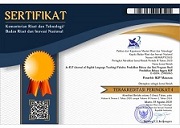Developing Tiktok Learning Videos as Instructional Media to Engage Students’ Speaking Skills
Abstract
Currently, social media usage and education are tightly connected. However, teachers and students are still exposed to new obstacles as the situation changes. In the preliminary study, the researcher discovered that one of the issues was the lack of student engagement while using technology in learning speaking through online learning. Thus, the aim of this study is to develop a TikTok as instructional videos for SMPN 3 Singkawang in order to engage their speaking skills. The design of this study is a research and development design that applies ADDIE work procedures (Analysis, Design, Development or Production, Implementation or delivery, and Evaluation). The participants of the research were an English teacher and 30 junior high school students in SMPN 3 Singkawang. Qualitative data were collected from pre-observation during online classes, semi-structured interviews, and observation. On the other hand, quantitative data were collected from questionnaires as needed analysis, expert judgment, and observation sheets in the implementation phase that used the Likert scale percentage. The material expert got 55 points from 60/93.75%, categorized as very good, the Media expert got 75 from 80/91.66%, categorized as Very good. The score from the observation sheet results in the implementation stage is 89,58% which indicated that the media is in a very good category to use as a learning tool to engage speaking skills. Thus, Tiktok instructional videos have proven that it could engage students’ speaking skills.
Keywords
Full Text:
PDFReferences
Branch, R. M. (2010). Instructional design: The ADDIE approach. In Instructional Design: The ADDIE Approach. Springer US.
Cuccurullo, D., & Cinganotto, L. (2015). The role of videos in teaching and learning content in a foreign language. Journal of E-Learning and Knowledge Society Je-LKS The Italian e-Learning Association Journal, 11(2), 49–62. https://doi.org/10.20368/1971-8829/1024
Dilon, C. (2020). Tiktok influences on teenagers and young adults students: The common usages of the application tiktok. American Scientific Research Journal for Engineering, Technology, and Sciences, 68(1), 132–142.
Fahrurozi, S. K., Maryono, D., & Budiyanto, C. W. (2017). The Development of Video Learning to Deliver a Basic Algorithm Learning. IJIE (Indonesian Journal of Informatics Education), 1(1), 49-56. https://doi.org/10.20961/ijie.v1i2.12446
Fiallos, A., Fiallos, C., & Figueroa, S. (2021). Tiktok and Education: Discovering Knowledge through Learning Videos. Eight International on e Democracy & eGovernment (ICEDEG), pp. 172-176. http://dx.doi:10.1109/ICEDEG52154.2021.9530988
Guo, J. (2021). Research on the Influence of TikTok on Teenagers. Proceedings of the 2021 International Conference on Social Development and Media Communication (SDMC 2021), 1390-1393. https://doi.org/10.2991/assehr.k.220105.254
Jamila, A., & Nasir, E. (2021). Problematika Guru dan Siswa dalam Proses Pembelajaran Daring pada Masa Pandemi Covid-19 di UPTD SMP Negeri 1 Parepare. Al Ma' Arief: Jurnal Pendidikan Sosial Dan Budaya. 3(2), 101-110.
Masdiana. (2021). Media Dengar dan Pandang. In Media Pembelajaran (Ed.), Fatma Sukmawati. Tahta Media Group.
Mohsin, M. (2022). 10 Tiktok statistics you need to know in 2021. Retrieved April 5, 2021, from https://www.oberlo.com/blog/social-media-marketing-statistics
Nunan, D. (2003). Practical english languge teaching (1st ed). 1221 Avenue of the Americas: New York
Ou, C., Joyner, D. A., & Goel, A. K. (2019). Designing and developing video lessons for online learning: A seven-principle model. Online Learning Journal, 23(2), 82–104. https://doi.org/10.24059/olj.v23i2.1449
Pratiwi, A. E., Ufairah, N. N., & Sopiah, R. S. (2021). Utilizing TikTok Application As Media For Learning English Pronunciation. Proceedings International Conference on Education of Suryakencana 2021, July 2018, 1–7.
Rahmawati, Y., & Anwar, K. (2022). The Use Of Tiktok Application: The Impact On Students’ Vocabulary And Attitude. Professional Journal of English Education, 5(3), 610-621.
Ramli, M. (2012). Media Teknologi Pembelajaran. Copyperdana Media dan Teknologi Pembelajaran. Banjarmasin: IAIN Antasari Press.
Saputri, D. Y., Rukayah, & Indriayu, M. (2018). Integrating Game-based Interactive Media as Instructional Media : Students’ Response. Journal of Education and Learning (EduLearn). 12(4), 638–643. https://doi.org/10.11591/edulearn.v12i4.8290
Syarifuddin & Sinta. (2022). The Development of Online Learning Media Based on TikTok for Teaching Local Wisdom Course During the Covid-19 Pandemic. International Journal of Interactive Mobile Technologies, 16(22), 127–141. https://doi.org/10.3991/ijim.v16i22.36149
Tarisci, M. (2017) PEMBUATAN MEDIA VIDEO PEMBELAJARAN DAN IMPLEMENTASI TERHADAP HASIL BELAJAR PADA MATERI KULTUR JARINGAN DI SMA MUHAMMADIYAH 09 KUALUH-HULU T.P 2016/2017. In: Prosiding Seminar Nasional III Biologi dan Pembelajarannya, 8 September 2017, Universitas Negeri Medan.
Thornbury, S. (2005). How to Teach Speaking. England: Pearson Education Limited Longman.
Tomlinson, B. (Ed.). (2011). Materials Development In Language Teaching (2nd ed.). Cambridge: Cambridge University Press
Prawanti, L. T., & Sumarni, W. (2020). Kendala Pembelajaran Daring Selama Pandemi Covid-19. Prosiding Seminar Nasional Pascasarjana UNNES. 286-291. ISSN: 2686 6404.
Wisada, P. D., Sudarma, I. K., & Yuda, S, A. (2019). Pengembangan Media Video Pembelajaran Berorientasi Pendidikan Karakter. Journal of Education Technology, 3(3), 140. https://doi.org/10.23887/jet.v3i3.21735
Yang, H. (2020). Secondary-school Students’ Perspectives of Utilizing Tik Tok for English learning in and beyond the EFL classroom. 3rd International Conference on Education Technology and Social Science (ETSS 2020). 162-183.
Zaitun, H. M. S., & Indriani, E. D. (2021). TikTok as a Media to Enhancing the Speaking Skills of EFL Student’s. Jurnal Studi Guru Dan Pembelajaran, 4(1), 89–94.
DOI: https://doi.org/10.33394/jo-elt.v10i1.7277
Refbacks
- There are currently no refbacks.
Copyright (c) 2023 Sri Ajeng Jatry Ningsih, Yohanes Gatot Sutapa Yuliana, Ikhsanudin

This work is licensed under a Creative Commons Attribution-ShareAlike 4.0 International License.
Jo-ELT (Journal of English Language Teaching) Fakultas Pendidikan Bahasa dan Seni Program Studi Pendidikan Bahasa Inggris IKIP is abstracted/indexed in the following databases:
Published by Faculty of Culture, Management, and Business
Universitas Pendidikan Mandalika
p-ISSN: 2355-0309 | e-ISSN : 2548-5865
email: [email protected]
 Jo-ELT (Journal of English Language Teaching) Fakultas Pendidikan Bahasa dan Seni Program Studi Pendidikan Bahasa Inggris IKIP is licensed under a Creative Commons Attribution-ShareAlike 4.0 International License.
Jo-ELT (Journal of English Language Teaching) Fakultas Pendidikan Bahasa dan Seni Program Studi Pendidikan Bahasa Inggris IKIP is licensed under a Creative Commons Attribution-ShareAlike 4.0 International License.





1.jpg)


.png)







1.png)

.png)








